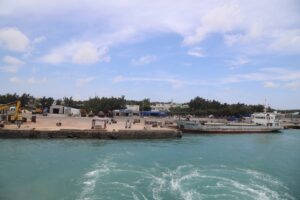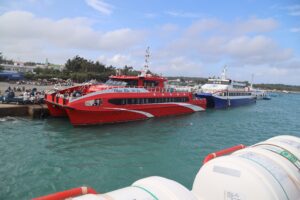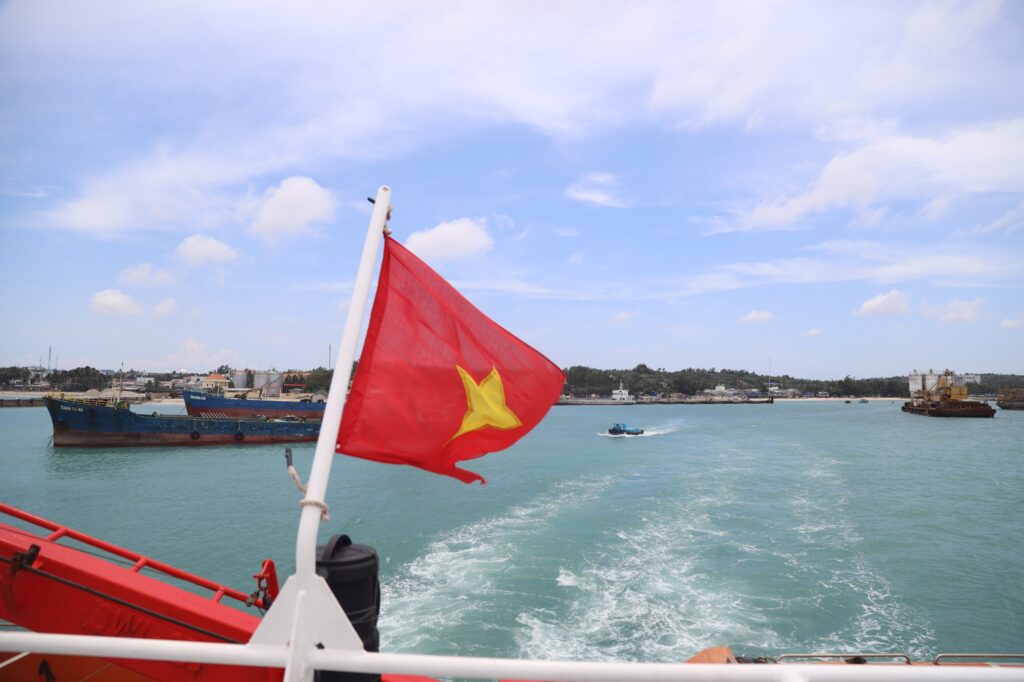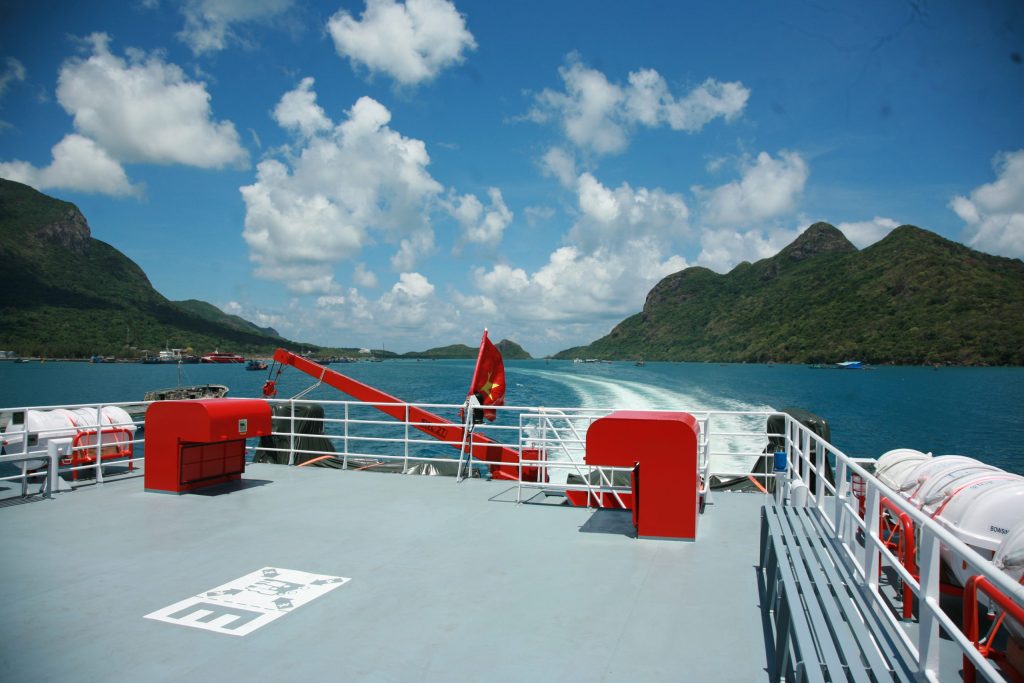Most religious sites are commonly referred to by locals as “Miếu” (Shrines). For example, the Thành Hoàng Shrine in Mỹ Khê village, and the Phú village Shrine, which enshrine the village tutelary deities associated with the communal house system, are still called “Miếu,” and their main gates bear that name. The temple dedicated to Master Sài Nại is called “Dinh Thầy Nại” (Master Nại’s Residence).
Temple of Princess Bàn Tranh
The Temple of Princess Bàn Tranh is located in Long Hải commune, established by the Cham people around the late 15th to early 16th century on a large site near the foot of Cao Cát Mountain, in an area known locally as Bà Chúa’s rice field. The islanders still preserve eight royal decrees granting titles to Princess Bàn Tranh, issued during the reigns of Minh Mạng, Thiệu Trị, Tự Đức, Đồng Khánh, Duy Tân, and Khải Định emperors. Among these, five are specifically for Princess Bàn Tranh, and three were jointly granted to Princess Bàn Tranh and Master Sài Nại during the reigns of Tự Đức, Đồng Khánh, and Duy Tân.
The temple is not open daily but only during commemorative festivals. The original shrine was small with Cham architectural features but deteriorated over time. The current temple has been rebuilt larger and more solidly with reinforced concrete and wood, losing some of its original architectural character.
Temple of Master Sài Nại
Located in Ngũ Phụng commune, this 16th-century temple sits on a high hill northeast of An Hòa village. It houses eight royal decrees from the reigns of Minh Mạng, Thiệu Trị (two decrees), Tự Đức (two decrees), Đồng Khánh, Duy Tân, and Khải Định. Every year on the 4th day of the 4th lunar month, islanders from various villages organize a procession to bring Master Sài Nại’s royal decrees from their storage place to the temple for worship, an event called the “Giao phiên Kỵ Thầy” festival.
Temple of Lady Ngọc in Thương Hải village
Built in the 16th century, this temple preserves five royal decrees granted to Thiên Ya Na during the reigns of Tự Đức (two decrees), Đồng Khánh, Duy Tân, and Khải Định. Two main ceremonies are held annually: the spring ceremony in the first lunar month and the autumn ceremony in the eighth lunar month, which coincide with the worship of Ông Nam Hải of Thương Hải village.
Temple of Lady Ngọc in Hải Châu village
Situated in Ngũ Phụng commune and built in the late 18th to early 19th centuries, this temple lies to the right of Vạn Hải Châu within the same compound. The main altar worships Thiên Ya Na, with the right altar dedicated to Tiên sư and the left to Tiền hiền. The temple holds four royal decrees for Thiên Ya Na from the reigns of Tự Đức (two decrees), Đồng Khánh, and Duy Tân. Two main annual ceremonies are held in spring and autumn.
Temple of Lady Ngọc in Long Hải commune
Constructed in the early 19th century on a large plot surrounded by fruit gardens providing shade year-round. A large old banyan tree once stood in front of the temple, giving it the popular name “Miếu Cây Da” (Banyan Tree Shrine), but the tree no longer exists. The main hall has three altars: the central one for goddess Thiên Ya Na; the left and right for Tiền hiền and Hữu ban – Tả ban respectively. Three main annual ceremonies are held here: spring in the first lunar month, autumn in the seventh lunar month, and the memorial day for Lady Ngọc on the 8th day of the 10th lunar month. The royal decrees given by the Nguyễn emperors for this temple have been lost or destroyed.
Temple of Bạch Mã Thái Giám in Quý Thạnh village
Built around the early 19th century in Ngũ Phụng commune, the temple complex includes the main hall and a smokehouse. The main hall contains three altars: the central altar for Bạch Mã Thái Giám deity, the right for Tiền hiền, and the left for Hậu hiền. Five royal decrees for Bạch Mã Thái Giám are preserved from the reigns of Tự Đức (two decrees), Đồng Khánh, Duy Tân, and Khải Định. Annual ceremonies are held in the first and tenth lunar months, coinciding with major festivals at Vạn Quý Thạnh.
Temple of Bạch Mã Thái Giám in An Hòa village
Dating back to the late 18th century, this temple in Ngũ Phụng commune is linked to the migration of residents from the Ngũ Quảng region who settled and developed An Hòa village. It served the community’s spiritual and cultural needs. Five royal decrees for Bạch Mã Thái Giám are kept at Phú Mỹ communal house. Two annual ceremonies take place in mid-first lunar month and mid-seventh lunar month.
Trấn Bắc Temple
Located on Tranh Islet in Triều Dương village, Tam Thanh commune, and built in the early 19th century, this temple is often called “Miếu Trấn Bắc” by islanders. The main hall contains three altars: the central one for Trấn Bắc and Thiên Ya Na, the left and right altars for Tiền hiền and Hậu hiền. Bắc Quân Đô Đốc has three royal decrees from the Đồng Khánh era jointly honoring Bắc Quân Đô Đốc and Nam Hải deity, also from Đồng Khánh and Khải Định reigns. These decrees are kept at Vạn An Thạnh and are ceremoniously brought to Trấn Bắc temple during festivals before being returned for safekeeping.
Two main annual ceremonies occur here: on the 12th day of the 3rd lunar month to worship Bà Thiên Ya Na (Lady Ngọc), and on the 7th day of the 8th lunar month to worship Ông Trấn Bắc. The ritual sequence follows that of the Vạn An Thạnh festival.
Quan Thánh Temple in Ngũ Phụng commune
Built on a high hill northeast of An Hòa village, next to Master Sài Nại’s temple, the construction date is unknown. The main hall has three altars: central for Quan Thánh, right for Tả ban, and left for Hữu ban. Unlike some other temples dedicated to Quan Thánh, this temple does not have royal decrees for Quan Thánh but instead holds royal decrees for the Bạch Mã Thái Giám deity from the reigns of Tự Đức (two decrees), Đồng Khánh, and Duy Tân.
Miếu Chúa Thanh
Located in Long Hải commune next to Vạn Liên Thành, this small shrine was last rebuilt in 1998 using concrete, wood doors, and tile flooring. It was constructed by local contributions. The shrine is dedicated to the wandering souls on the island and sea, where during the Thanh Minh festival (around early third lunar month), locals hold ceremonies to honor these souls, alternating between vegetarian and non-vegetarian offerings yearly.
Miếu Bà Giàng
A simple small shrine near the northwest coast of Phú Quý island, dedicated to Bà Giàng according to local folk beliefs associated with the legend of Bà Giàng and Ông Đụn, an elderly couple without children. It is said that Bà Giàng was a shaman who met Master Sài Nại to help villagers resist Chinese pirates (“giặc Tàu Ô”) in the 18th-19th centuries. These pirates came from Java (Indonesia) on black-painted ships, hence the name “giặc Tàu Ô.” The small cement shrine is surrounded by many round stones painted white.










